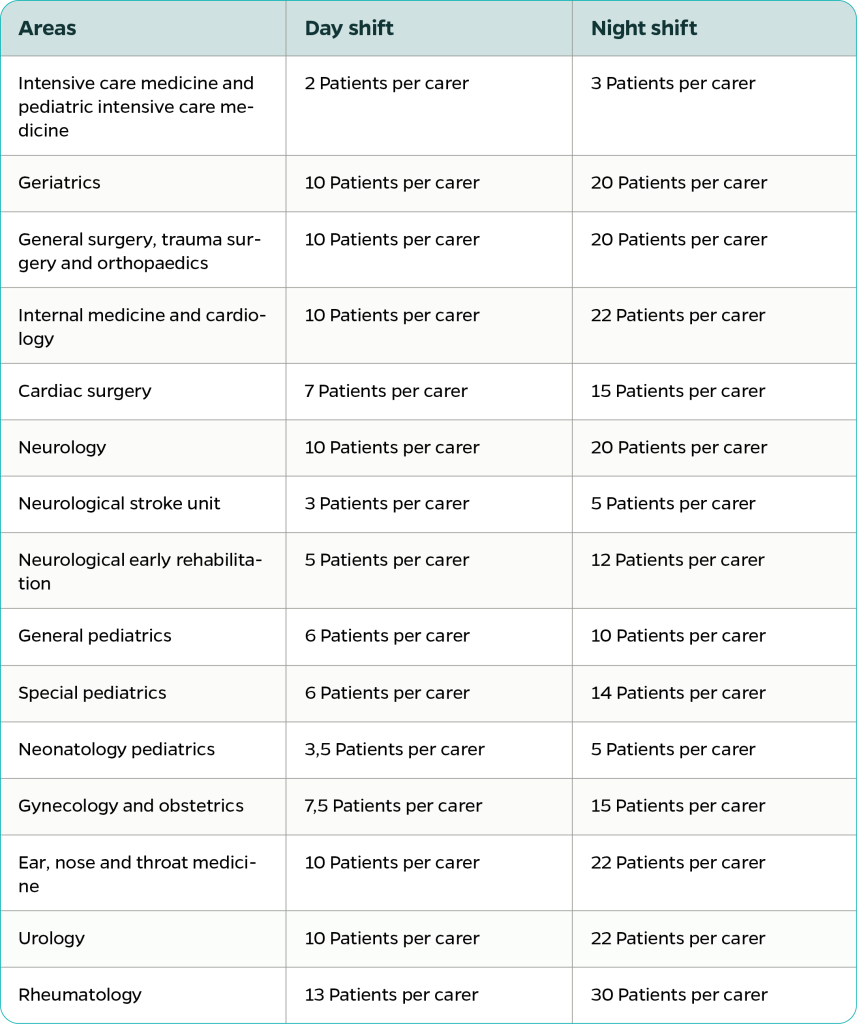Implementing of PpUGV with Workforce Management

The Nursing Staff Minimum Requirements Regulation (PpUGV) represents significant progress for the quality of patient care in German hospitals, particularly in connection with effective workforce management.
Inhalt
↓ What are nursing staff minimum requirements for hospitals and why are they important?
↓ Which employees are affected by the minimum personel level?
↓ What minimum staffing levels do the regulations appoint for hospitals?
↓ How is compliance with the PpUGV regulations checked?
↓ What are the risks of non-compliance?
↓ What functions does the plano solution offer for implementing the PpUGV? Which evaluations are possible?
What are nursing staff minimum requirements for hospitals and why are they important?
The Nursing Staff Minimum Requirements Regulation (PpUGV) establishes minimum staffing requirements for specific areas in hospitals and is a crucial step towards high-quality patient care. It was introduced in Germany in 2019 in response to concerns about nursing quality and also takes into account patient safety needs.
To better understand the impact of the PpUGV, it is important to consider the perspectives of both nurses and patients. The regulation provides a foundation, but the quality of health care is influenced by various factors, such as qualification, training and working conditions.
Which employees are affected by the minimum personel level?
Nursing staff in healthcare facilities such as hospitals are mainly affected. This includes nurses, carers and medical staff who work in direct patient care. The following areas are affected by the PpUGV and its requirements:
- General surgery
- Cardiac surgery
- Trauma surgery
- Orthopaedics
- Internal medicine
- Cardiology
- Geriatrics
- Gynecology and obstetrics
- Neurosurgery
- Neurology
- Neurological stroke unit
- Neurological early rehabilitation
- Intensive care medicine
- Pediatric intensive care
- General Pediatrics
- Special pediatrics
- Neonatology Pediatrics
- Ear, nose and throat medicine
- Rheumatology and urology
What minimum staffing levels do the regulations appoint for hospitals?

Source: https://www.bundesgesundheitsministerium.de/themen/pflege/pflegepersonaluntergrenzen.html
How is compliance with the PpUGV regulations checked?
Compliance with the minimum nursing personnel threshold (PpUGV) is checked by health authorities and supervisory bodies through regular inspections and audits. Complaints from patients can also lead to inspections. The results of such audits can lead to new requirements, sanctions or other regulatory measures to ensure compliance with the PpUGV.
What are the risks of non-compliance?
Non-compliance with the minimum personnel threshold in German hospitals can lead to various risks:
- Lack of quality in patient care
- Overworking of nursing staff
- Increased risk of errors and complications
- Patient dissatisfaction
- Legal consequences such as fines and claims for damages
What functions does the plano solution offer for implementing the PpUGV? Which evaluations are possible?
Real-time analysis of bed occupancy:
By seamlessly linking the current bed occupancy information from the existing KiS systems (hospital information systems) and comparing it with planning data, plano enables a real-time evaluation of the PpUGV. Bottlenecks can be identified and documented at an early stage.
Flexible management of exceptions:
The administration of exceptions to the PpUGV is extremely simple with plano. Exceptions can only be entered for unfulfilled areas / days. This makes administration with the plano WFM solution extremely simple and increases the transparency and traceability.
Customizable interfaces to bed occupancy data:
Our solution offers a flexible interface to bed occupancy data, which makes it possible to carry out cross-departmental or cross-area evaluations. For example, bed occupancy in different departments such as Cardiology 1 and Cardiology 2 can be analyzed separately.
INEC version for specific requirements:
With the InEK version of plano, hospitals can accurately meet specific requirements and regulations and optimize their processes.
Integration of forecast models:
Thanks to the flexibility in obtaining information on bed occupancy, a forecast model can also be integrated into plano. This makes it possible to forecast what planning would look like in the near or distant future, based on various bed occupancy scenarios.
Conclusion:
The PpUGV represents a significant step towards high-quality patient care in German hospitals. By defining minimum personnel requirements and monitoring compliance with them, it helps to improve the quality of health care and ensure patient safety. The integration of workforce management solutions facilitates the implementation of the PpUGV and supports hospitals in making their care processes more efficient.
Archive
Employee Retention in Retail
We’re Here for You
